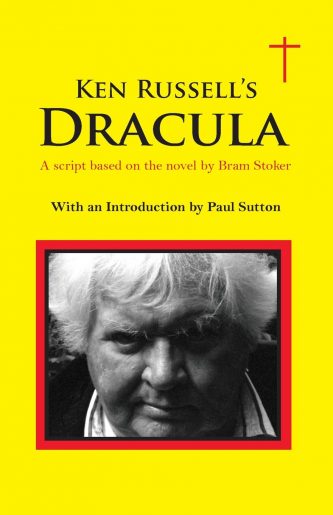 By KEN RUSSELL, PAUL SUTTON (Bear Claw Publishing; 2009/13)
By KEN RUSSELL, PAUL SUTTON (Bear Claw Publishing; 2009/13)
A mixed bag, this. It’s the screenplay for a never-made film of DRACULA by the late, notorious Ken Russell, Britain’s cinematic sultan of excess and outrage. The script was written in the late 1970s and published in 2009 by Russell biographer Paul Sutton.
According to a lengthy introduction by Sutton, the film came close to being made by Columbia only to be abandoned when Universal put its Frank Langella headlined version of DRACULA into production. Russell’s script, however, allegedly formed the impetus for a DRACULA ballet by Christopher Gable (the star of Russell’s 1968 film SONG OF SUMMER) and also Francis Ford Coppola’s 1992 filming of the story, whose screenwriter James V. Hart was directly involved in the inception of Russell’s interpretation.
As an admitted Ken Russell fanatic I’d like very much to say this screenplay is an unqualified triumph, and to be sure, it does contain some impressive things. It’s also a quintessentially Ken Russell concoction, with Russell’s famously extroverted voice evident in the opening pages, in which Jonathan Harker is attacked by a coachman-turned-werewolf. A slow-building exercise in atmospheric subtlety this isn’t!
You likely know the story of DRACULA even if you haven’t read Bram Stoker’s original text. It involves Harker traveling to the eponymous Count Dracula’s Transylvanian castle to conduct a real estate transaction, only to become trapped therein with three vampiric “sisters” while Dracula, a vampire himself, travels to England on a doomed schooner. In England Dracula gloms onto Harker’s fiancée Mina and her friend Lucy, and also the vampire-worshipping madman Renfield. Lucy begins to suffer from a mysterious ailment, which attracts the attention of Dr. Van Helsing, a vampire hunter, who together with Mina and Harker pursues Dracula back to his lair in Transylvania.
Russell’s version of the story has been moved forward from the 1890s to the 1920s. Lucy has been transformed into an opera diva, and Dracula into a personality-swapping aesthete (not unlike Gary Oldman’s characterization in Coppola’s DRACULA). Russell’s sense of cinema is evident throughout, particularly in an early sequence that masterfully intercuts Dracula on his sea voyage to England with Renfield anxiously awaiting his master’s arrival in his padded cell. Russell’s revamped ending, meanwhile, is very likely the finest of any version of DRACULA, with the Count meeting his fate in a mythologically-inspired manner so perfect I’m amazed nobody else has utilized it.
Again, however, the script as a whole is not the masterwork I was anticipating. It’s highly uneven and under-baked, with Dracula and Jonathan Harker having too little screen time and Dr. Seward, who treats Lucy and Renfield, granted far too much. The dialogue, furthermore, is inconsistent: toward the end Van Helsing suddenly takes to speaking in Object-subject-verb word order (or Yoda-speak), and quite a few monologues are left incomplete, concluding with “etc.” Even the copious hallucinatory episodes recognizable to any Russell fan are presented in perfunctory and underdeveloped fashion.
I imagine these and other scenes would have been more properly fleshed out onscreen, which illuminates this script’s most glaring flaw: it’s status as an incomplete blueprint is all-too evident. Blueprints, of course, are precisely what all screenplays truly are, which explains why they’re rarely ever fully satisfying in and of themselves. That’s certainly the case with KEN RUSSELL’S DRACULA, whose final and intended form is only hinted at here.
